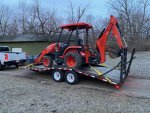You are correct a 1/2 ton pickup is really too light duty to be pulling a 10,000lb trailer. It will do it, but if done repeatedly (commercially), you will likely see components fail, such as the wheel bearings, axles, differentials, driveshaft u-joints, transmissions, brakes, etc. Your comment on the EcoBoost "easily" towing 14k lbs is not accurate. No pickup truck tows 14,000lbs "easily" and that includes modern 1-ton dually diesels with 1,000lb-ft or torque. You will feel that load and the engine will work. The EcoBoost is an impressive engine for its size and output, but there is a reason it is not offered in Ford's heavy-duty lineup, because it won't hold up. If you compare a 1/2 ton truck's frame, axles, suspension, driveshafts, brakes, etc, etc...so a 3/4 ton or up...there is a world of difference in size.
You commented on towing 10k lbs behind your Tundra as not being "worse" than having 2500lbs in the bed of your truck. I would disagree, because 10,000lbs of inertia trying to control your truck is a lot worse than 2500lbs of inertia added to the bed of your truck. But frankly, 2500lbs is too much for a half ton truck, and doing that a few times will cause problems. The axle tubes themselves are stressed at this point.
Finally, your future plans are mostly on point. If you want a 3/4 ton, you are right that a gas engine gives you significantly better payload, although likely less max towing. Sometimes the diesel engine provides a heavier duty transmission and rear axle, things to consider. Diesel engines move very heavy loads with less RPM and effort, and use less fuel doing it, but right now the cost of diesel is much higher than gas, and the added cost of the diesel engine option (+$10k) is a lot. In my opinion, the best gas powertrain right now is the Ford 7.3L "Godzilla" engine with the 10-speed automatic transmission. Very understressed engine that is simple to work on and should last forever.
As a quick example, I have three trucks I tow with - a 2005 F-350 dually crew cab pickup with the 6.0L Powerstroke, a 2003 F-550 dump truck with the 6.0L Powerstroke, and a 2022 RAM 2500 crew cab with the 6.4L Hemi / 8-speed combination. Both the pickups have gooseneck hitches in the bed and both have factory trailer brake controllers. The 550 is a dump truck with a pintle hitch. I have a 30' gooseneck (16k) and an 18' deckover (16.5k) for moving my equipment. The normal load is a Kubota MX6000 cab tractor, loader, and 7-foot flail mower, loaded rear tires, spacers, etc. The tractor weighs in at 7,244lbs and the flail mower is another 1300lbs or so. The gooseneck trailer weighs in at 5,700lbs approximately, leaving 10,300lbs capacity. My tractor and mower together end up being roughly 8500lbs, so I have a little room left on the trailer. Sometimes I bring my Wright zero turn mower (1300lbs) along and basically max out the trailer. I have pulled this load with my RAM 2500 gas truck, and my conclusion is its too much for a 2500. The load needs to be carefully balanced or the back end of the truck sags. Goosenecks put 15-20% of the weight into the bed, more than the 10-15% on the bumper pull trailer. My RAM has a factory rating of 3100lbs of payload and 14,700lbs of towing (3.73 axle ratio). The gas engine has enough power to move the load, but it works very hard on hills and grades. I really like the 8-speed transmission, but I suspect if I towed this load repeatedly, the transmission would not have a long life. Also, with the 2500's lighter suspension, you get pushed around by the gooseneck especially with a tall tractor on it. However, this truck tows my 8,000lb 20' enclosed box trailer very well. Towing this same gooseneck fully loaded with the dually pickup is a much better experience. The dually offers so much better stability and the trailer cannot bully the truck nearly as much. There is less squat. I'm not going to say the diesel engine is effortless with this load, because its not, but it works less hard than the gas V8, despite only a 5-speed automatic transmission. The 550 dump truck is a similar experience except it has a massive rear axle, suspension, and brakes that dwarf what the 350 dually has. Squat and control are not an issue. The 4.88 axle ratio helps move things along. But that truck works as well.
I had a 2019 RAM 3500 (single rear wheel) with the High Output Cummins and towed this load as well. The added power makes life even easier, but it is still not effortless, and the dually still is far more stable.
I think it depends upon what you want. A half ton pickup can do a lot of work but still drives great around town and can do pretty well on fuel. They ride and steer nicely. A 3/4 ton rides quite a bit worse and the steering isn't as precise or quick. They don't accelerate or stop as fast as a half-ton, and they use quite a bit more fuel. However, they can be loaded down with payload or trailer far more than a half ton can be.


